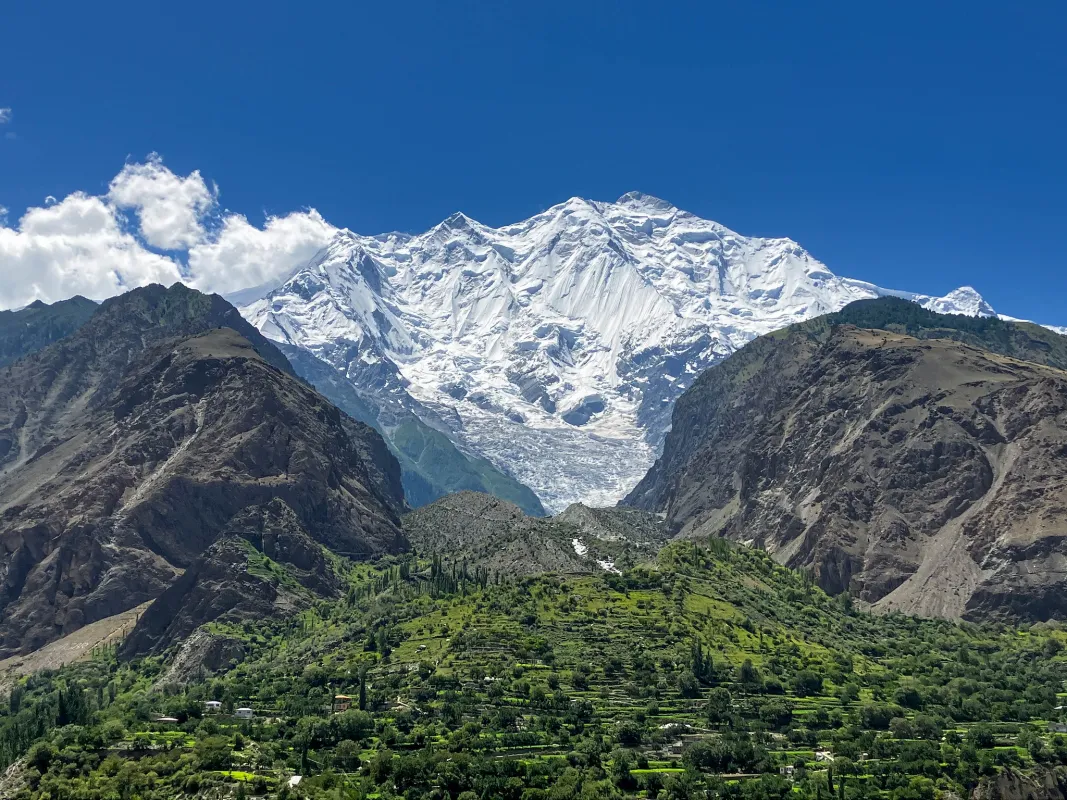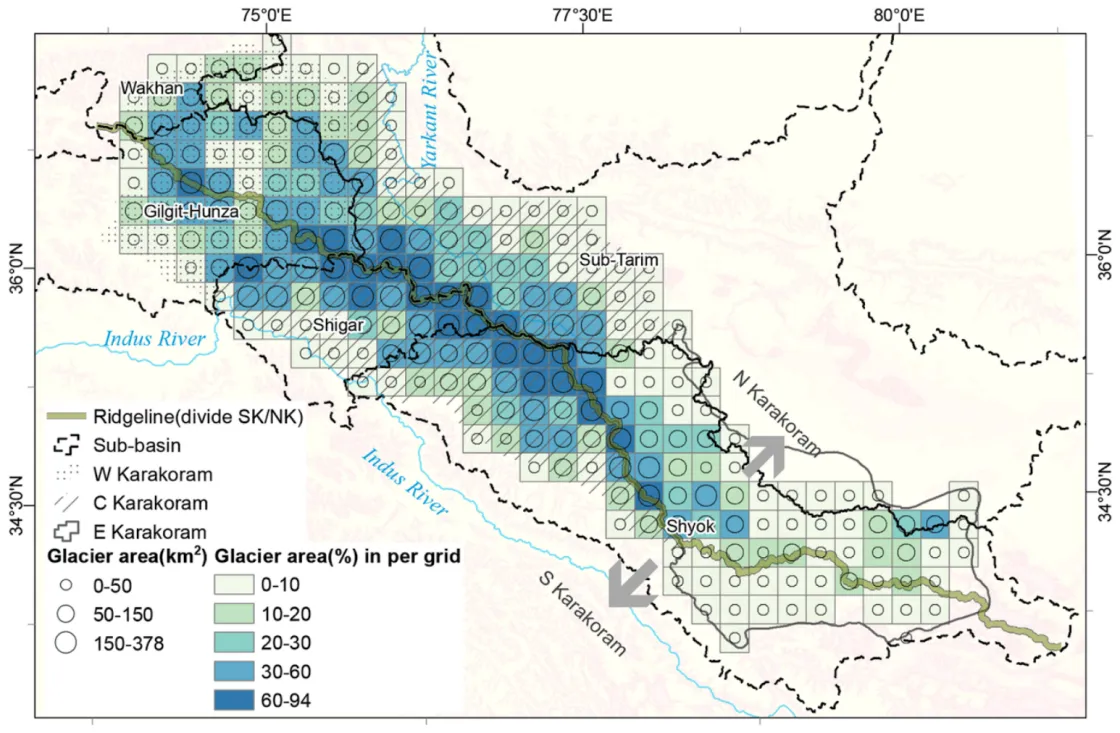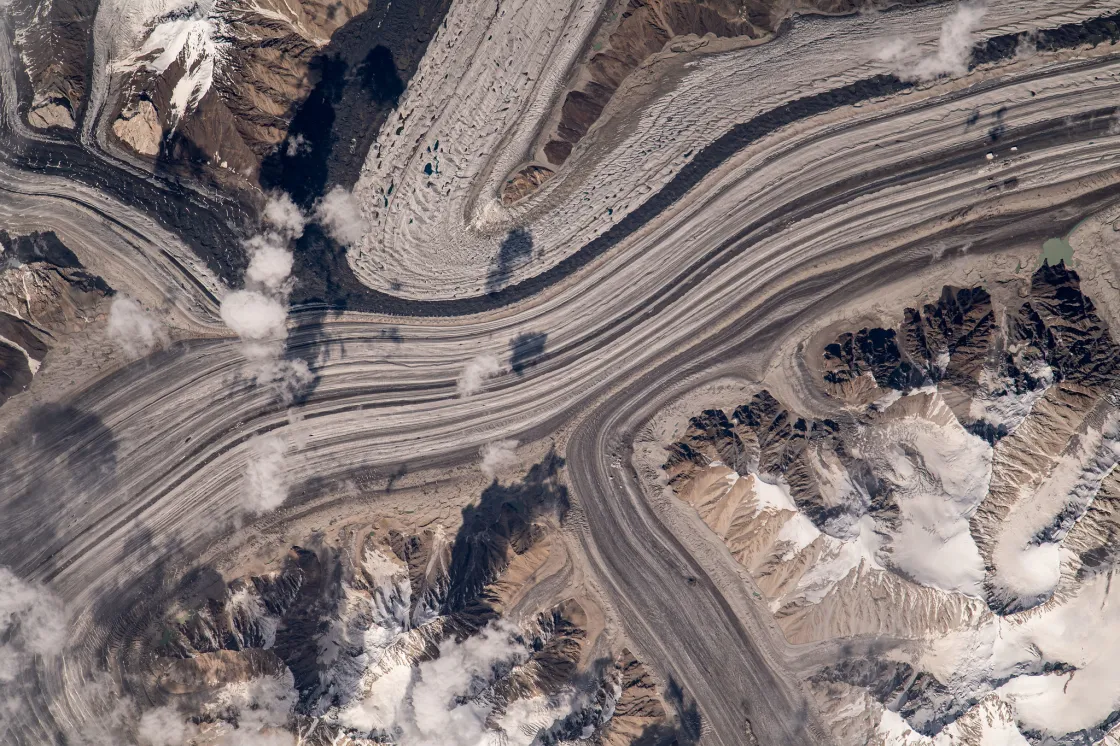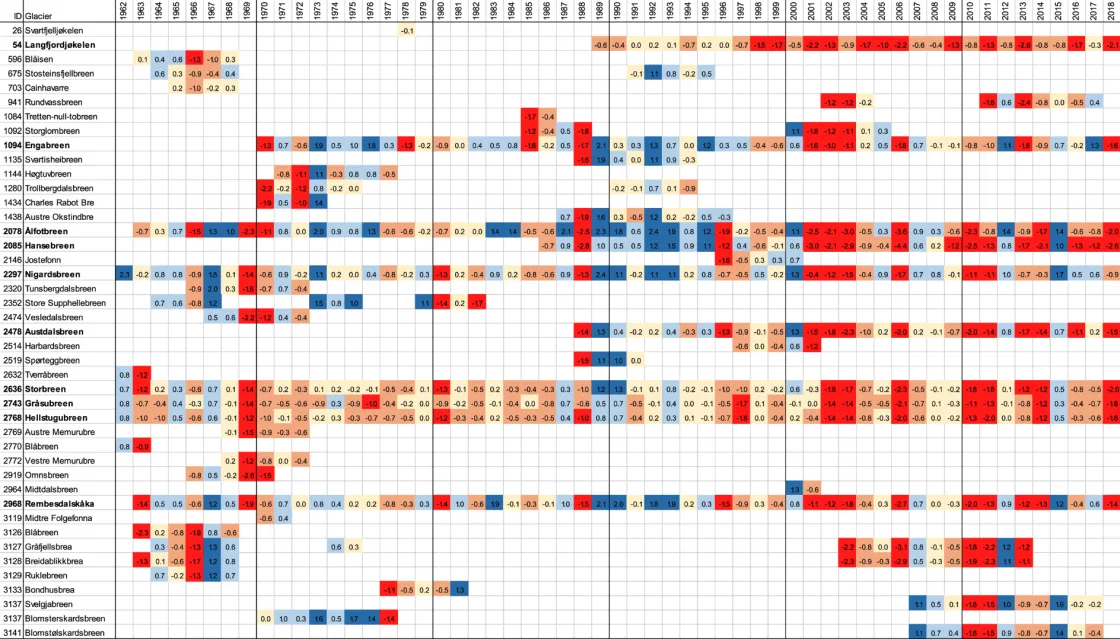By Michon Scott
Most mountain glaciers outside the polar regions are losing ice. In the 1990s, however, glaciologists noticed an exception. In the Karakoram (pronounced keh·ruh·kaw·ruhm) Range—a mountainous region straddling the borders of Pakistan, India, Afghanistan, Tajikistan, and China—glaciers have experienced modest gains. This unusual behavior has earned the nickname “Karakoram Anomaly.”
Since the late 1990s, glaciologists have proposed multiple explanations for the anomaly. Current explanations generally favor weather patterns unique to the region. Glaciologists have also pondered how long the anomaly is likely to persist in a warming climate, though many doubt that it can outlast continued warming for very long.
A fascinating but forbidding region
When snow accumulates over centuries or millennia, it can form a glacier: a slow-flowing icy mass. Snow adds to glacier mass while evaporation and melt (also known as ablation) subtract from glacier mass. When accumulation and ablation roughly equal each other, the glacier is in balance.
The Karakoram Range is part of High Mountain Asia and it holds some of the world’s tallest mountains. The Karakoram is also one of the world’s most glacier-rich areas outside of the polar regions. It contains more than 13,000 glaciers covering more than 20,000 square kilometers (7,700 square miles). Many glaciers of the Karakoram span thousands of vertical meters; some of them start at an elevation above 7,000 meters (23,000 feet); some descend to an elevation of 2,300 meters (7,500 feet); many have a vertical range of over 4,500 meters (14,800 feet).
Rugged terrain and disputed borders have long limited on-site observations of the Karakoram, and records from meteorological stations are confined to the last several decades. Improvements in remote sensing technology, such as better estimates of surface elevation changes, combined with on-site observations and calculations of glacier gains and losses, indicate that Karakoram glaciers have experienced slight gains. Geology professor Kenneth Hewitt described the Karakoram Anomaly in a 2005 paper, highlighting observations of mass gains in the 1990s. Description of the phenomenon kicked off years of research into possible causes.
Dust and debris
One of the first explanations for the Karakoram Anomaly involved glacial debris.
Pristine snow is highly reflective; as much as 90 percent of the sunlight reaching that snow surface bounces back into space. When a layer of dust, soot, or algae coats snow, it becomes less reflective, absorbing more energy and melting faster. In contrast, a thick layer of debris insulates ice. Whether from windblown sources or rocks falling onto a glacier surface, debris regulates heat exchanges between the ice and the atmosphere. Hewitt explained that, once debris thickness exceeds 4 or 5 centimeters (less than 2 inches), it starts to reduce ablation. A debris layer thicker than 1 meter (3 feet) reduces ablation to a negligible degree, protecting the glacier very effectively. Debris-covered glaciers dominate the Karakoram region. Yet debris is probably not a new phenomenon there. Karakoram glaciers have likely collected debris from avalanches and rockfalls for centuries or millennia.
If Karakoram glaciers really started to gain mass in the 1990s, a different explanation was needed.
Enter weather from the west
So, if not debris, what about Karakoram could explain the anomaly? Karakoram weather is influenced by wind, but winds affecting the Karakoram differ from the winds driving weather across other parts of High Mountain Asia and the Indian subcontinent. Winds blow from the northeast during the cool months, and blow from the southwest during the warmer months, often soaking the subcontinent with rain. By contrast, the Karakoram receives most of its precipitation as wintertime snowfall, with the moisture carried by westerly winds originating in the Mediterranean and Caspian Sea regions.
So much precipitation falling on the Karakoram as snow may protect it from the kind of glacier mass loss witnessed in other parts of High Mountain Asia, where glacier retreats and slowdowns are commonplace.
A 2020 review paper concluded that meteorological forcing, in particular westerly winds, slightly increased snowfall, likely contributing to Karakoram glaciers exhibiting slight growth while other glaciers, including most across High Mountain Asia, experiencing declines.
A 2022 study examined Karakoram precipitation from 1980 to 2019. Study authors found that, after the start of the twenty-first century, wintertime precipitation intensity for the Karakoram rose by roughly 10 percent although the frequency of western disturbance weather events remained steady across the study period.
Questions remain
While scientists have a possible explanation for what has historically contributed to the Karakoram Anomaly, the region’s behavior still prompts questions and debates.
One question focuses on the true location of the anomaly, with multiple studies suggesting a slightly different area for the anomaly: not the Karakoram exclusively, but instead the eastern part of the Karakoram and the western Kunlun Shan mountain ranges. This somewhat shifted area contains glaciers remaining largely in balance.
A more significant question concerns just how unusual current Karakoram glacier behavior is. In other words, if it’s really earned the title of an “anomaly.” In 2020, glaciologist Daniel Farinotti and coauthors argued that glacier behavior should markedly differ from regional patterns to qualify as an anomaly, and that the glacier behaviors referred to as the “Karakoram Anomaly” might better be described as simply characteristic of the region. In other words, glacier behavior that seems out of character on a global scale might not be unusual for the eastern Karakoram and western Kunlun Shan.
Yet an even bigger question concerns how long Karakoram glaciers are likely to withstand ice loss in a warming world. An instructive example might come from Norway. A 2020 study examined Norwegian glacier mass balance records spanning 1962 to 2018. During the 1990s, more than half the observed glaciers showed gains, but those gains did not last. In fact, balances for those glaciers turned sharply negative in the 2000s.
A 2023 study led by glaciologist Fuming Xie suggested that the continued stability of the Karakoram glaciers is not guaranteed to last. The authors found an increasing trend from 1990 to 2010 but a decreasing trend after the 2010s, writing, “This may indicate a weakening of the abnormal behaviour (sp.) of glaciers in the Karakoram owing to the continuous warming.”
Only future observations will definitively answer the question of whether slight gains or steady states in Karakoram glaciers will persist and for how long.
Explore data
The National Snow and Ice Data Center Distributed Active Archive Center (NSIDC DAAC) distributes data related to High Mountain Asia and global glaciers.
References
Andreassen, L.M., H. Elvehøy, B. Kjøllmoen, and J.M.C. Belart. 2020. Glacier change in Norway since the 1960s – an overview of mass balance, area, length and surface elevation changes. Journal of Glaciology 66(256): 313-328. https://doi.org/10.1017/jog.2020.10
Collier, E., F. Maussion, L.I. Nicholson, T. Mölg, W.W. Immerzeel, and A.B.G. Bush. 2015. Impact of debris cover on glacier ablation and atmosphere–glacier feedbacks in the Karakoram. The Cryosphere 9(4): 1617-1632. https://doi.org/10.5194/tc-9-1617-2015
Dehecq, A., N. Gourmelen, A.S. Gardner, F. Brun, D. Goldberg, P.W. Nienow, E. Berthier, C. Vincent, P. Wagnon, and E. Trouvé. 2019. Twenty-first century glacier slowdown driven by mass loss in High Mountain Asia. Nature Geoscience 12: 22-27. https://doi.org/10.1038/s41561-018-0271-9
Farinotti, D., W.W. Immerzeel, R.J. de Kok, D.J. Quincey, and A. Dehecq. 2020. Manifestations and mechanisms of the Karakoram glacier Anomaly. Nature Geoscience 13: 8-16. https://doi.org/10.1038/s41561-019-0513-5
Gao, H., X. Zou, J. Wu, Y. Zhang, X. Deng, S. Hussain, M. Atif Wazir, and G. Zhu. 2020. Post-20th century near-steady state of Batura Glacier: observational evidence of Karakoram Anomaly. Scientific Reports 10: 987. https://doi.org/10.1038/s41598-020-57660-0
Hewitt, K. 2005. The Karakoram Anomaly? Glacier expansion and the ‘elevation effect,’ Karakoram Himalaya. Mountain Research and Development 25(4): 332-340. https://doi.org/10.1659/0276-4741(2005)025[0332:TKAGEA]2.0.CO;2
Javed, A., P. Kumar, K.I. Hodges, D.V. Sein, A.K. Dubey, and G. Tiwari. 2022. Does the recent revival of western disturbances govern the Karakoram Anomaly? Journal of Climate 35(13): 4383-4402. https://doi.org/10.1175/JCLI-D-21-0129.1
Kääb, A., E. Berthier, C. Nuth, J. Gardelle, and Y. Arnaud. 2012. Contrasting patterns of early twenty-first-century glacier mass change in the Himalayas. Nature 488: 495-498. https://doi.org/10.1038/nature11324
Kapnick, S.B., T.L. Delworth, M. Ashfaq, S. Malyshev, and P.C.D. Milly. 2014. Snowfall less sensitive to warming in Karakoram than in Himalayas due to a unique seasonal cycle. Nature Geoscience 7: 834-840. https://doi.org/10.1038/ngeo2269
Racoviteanu, A.E. K. Rittger, and R. Armstrong. 2019. An automated approach for estimating snowline altitudes in the Karakoram and Eastern Himalaya from remote sensing. Frontiers in Earth Science https://doi.org/10.3389/feart.2019.00220
Xie, F., S. Liu, Y. Gao, Y. Zhu, T. Bolch, A. Kääb, S. Duan, W. Miao, J. Kang, Y. Zhang, X. Pan, C. Qin, K. Wu, M. Qi, X. Zhang, Y. Yi, F. Han, X. Yao, Q. Liu, X. Wang, Z. Jiang, D. Shangguan, Y. Zhang, R. Grünwald, M. Adnan, J. Karki, and M. Saifullah. 2023. Interdecadal glacier inventories in the Karakoram since the 1990s. Earth System Science Data 15(2): 847-867. https://doi.org/10.5194/essd-15-847-2023





